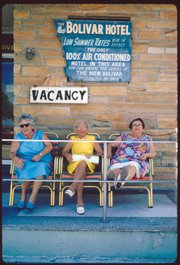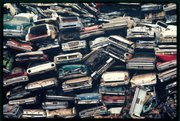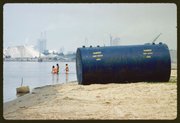An exhibit titled "Searching for the Seventies" might lead viewers to expect images of Woodstock, Vietnam, pot parties and tie-dye.
That's not what's hanging in the galleries of the Fort Smith Regional Art Museum Sept. 7 through Oct. 29.
FAQ
‘Searching for the Seventies’
WHEN — Sept. 7-Oct. 29
WHERE — Fort Smith Regional Art Museum
COST — Free
INFO — fsram.org
BONUS — A closing reception is set for 7-10 p.m. Oct. 28 as part of RAM’s annual Art Affair. Tickets are $100.
"'Searching for the Seventies: The DOCUMERICA Photography Project' is an exhibition created by the National Archives and Records Administration and organized for travel by the Smithsonian Institution Traveling Exhibition Service," says Kathrin V. Halpern, a project director for SITES.
Instead of looking at the pop culture of the decade, "in 1971, the newly established U.S. Environmental Protection Agency launched the DOCUMERICA Photography Project with the goal of documenting environmental troubles and triumphs across the country," explains Melissa Conry, marketing assistant for FSRAM. "About 70 photographers, including Flip Schulke, John Corn, Danny Lyon, John H. White and Lyntha Scott Eiler, completed 115 separate assignments between 1972 and 1977. What emerged was a moving and textured portrait of America."
"SITES worked with the EPA on traveling exhibits from this project in the 1970s," adds Halpern. "The exhibition [as it is today] was shown at the National Archives in Washington, D.C., from March 8 to Sept. 8, 2013. The national tour opened Feb. 14, 2015, at the Upcountry History Museum-Furman University in Greenville, S.C., [and] the exhibition will continue to tour through January 2019."
Writing in the National Archives' Prologue Magazine, C. Jerry Simmons credits the project "for the United States' first serious examination of its rapidly decaying natural environment." Its mission was to "pictorially document the environmental movement in America" during the decade, "effectively [focusing] on popular but valid environmental concerns of the early 1970s: water, air, and noise pollution; unchecked urbanization; poverty; environmental impact on public health; and youth culture of the day.
"But in reaction to the varied pollution, health and social crises," he writes, "DOCUMERICA succeeded also in affirming America's commitment to solving these problems by capturing positive images of human life and Americans' reactions, responses, and resourcefulness."
Halpern explains there are 90 photographs in the traveling exhibition, chosen from literally thousands of possibilities.
"The records for the project are housed with the National Archives and Records Administration," she says. "There are some 22,000 photographic slides, of which 16,000 images have been digitized."
Subjects range from Michael Philip Manheim's "dramatic photographs of a noise pollution crisis in the Neptune Road neighborhood near Logan Airport's main runway in East Boston" while "photographer Jack Corn went underground in West Virginia and Tennessee, where he captured images of coal miners and their families coping with miningrelated injuries and the dreaded black lung disease. [And] Bill Gillette documented a mining crisis in Colorado that eventually destroyed an entire town."
But along with the images of "loss and tragedy," the project "also collected images of Americans making a difference and creating positive change in their own lives and their surroundings," Simmons writes, including David Hiser's images of Michael Reynolds, "a visionary architect and environmental activist," and Charles O'Rear's photos of southeastern Nebraska, considered the healthiest place in the United States in the early 1970s.
"I love the breadth of images in the exhibition; together they really capture the turbulent spirit of the 1970s," Halpern says. "I think one of my favorite images is actually the one by Gene Daniels that the Fort Smith Regional Art Museum is using on their exhibition postcard. That stack of smashed cars in an auto dump -- all those colors, textures. But the real reason it's a favorite of mine is because it seems to be a real conversation starter in the gallery.
"I'll share a little secret: Many of us who work on exhibitions like to come into a gallery or exhibition space we've worked on when the public is visiting and observe how they respond to the exhibition," she reveals. "This particular photograph always gets people talking, especially inter-generational groups -- they point out the different makes and models, who owned what and when, which car was connected to a particular life event. It's really wonderful to see!
"I think there's something for just about everyone in the selection of photographs in this exhibition," Halpern concludes. "There is something surprisingly familiar in many of the photographs, something recognizable to our own period. I think that's reassuring in a way given our own turbulent times."
NAN What's Up on 09/01/2017






